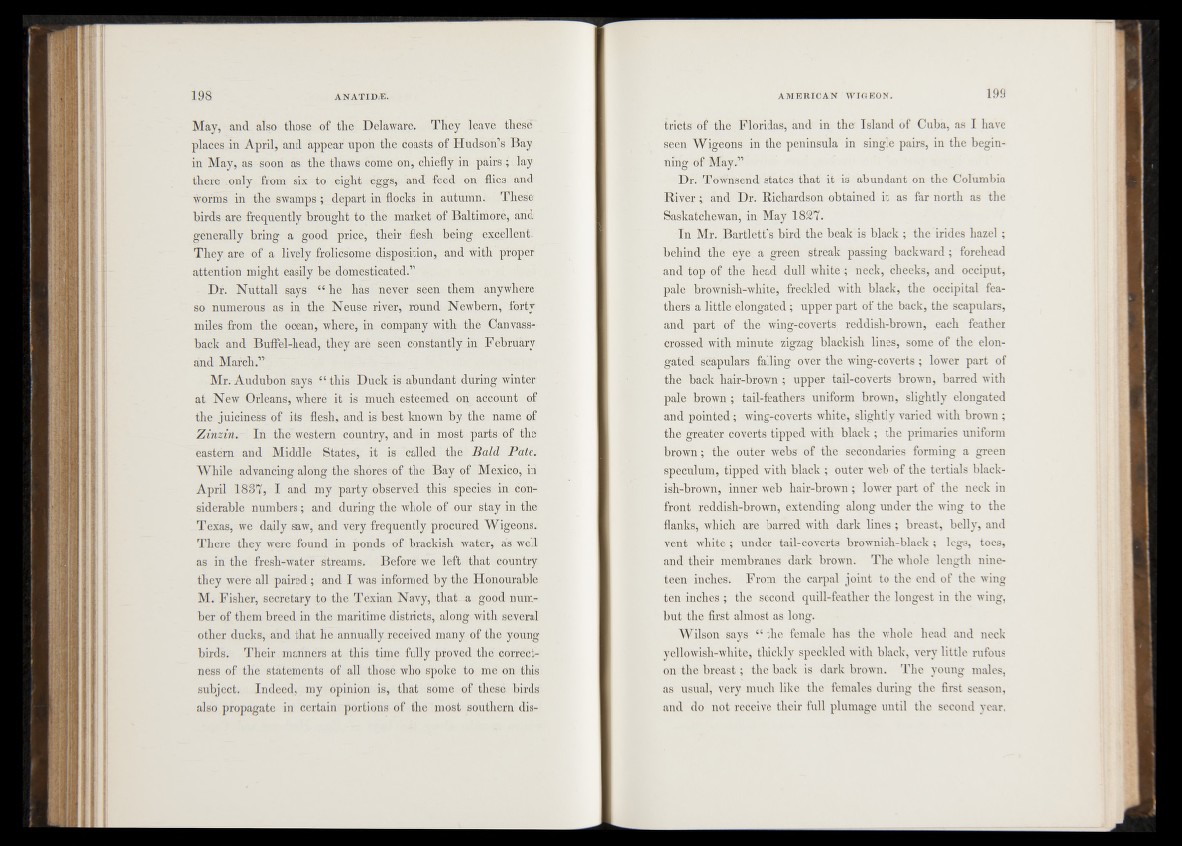
May, and also those of the Delaware. They leave these"
places in April, and appear upon the coasts of Hudson’s Bay
in May, as soon as the thaws come on, chiefly in pairs ; lay
there .only from six to eight éggs, and feed on flies and'
worms in the swamps ; depart in flocks in autumn; These1
birds are frequently brought to the market of Baltimore, and
generally bring a good price, their ' flesh being excellent ;
They are of a lively frolicsome disposition, and with proper*
attention might easily be domesticated.”
Dr. Nuttall says “ he has never seen them anywhere
so numerpus as in the Neuse river, round Newbern, forty
miles from the ocean, where, in company with thé Canvass-
back and Buffel-head, they are seen constantly in. February
and March.”
Mr. Audubon says “ this Duck isabundant during winter
at New Orleans, where it is much esteeméd oq. account of
the juiciness of its flesh, and is best known by the name of
Zinzin. In the western country, and in most parts of the
eastern and Middle States, it is called the Bald Pate.
While advancing along the shores of the Bay of -Mexico, in
April 1887, I and my party observed this species in Considerable
numbers; and during the whole of our stay in the
Texas, we daily saw, and very frequently procured Wigeons.
There they were found in ponds Of brackish water, as well
as in the fresh-water streams. Before we left that , country
they were all paired; and I was informed by the Honourable
M. Fisher, secretary fo the Texian Navy, that- a good number
of them breed in the maritime districts, along with several
other ducks, and that he annuallyreceived many of the young
birds. Their manners at this time fully proved the correctness
of the statements of all thosé who spoke to me on this
subject. Indeed, my opinion is, that some of thesé birds
also propagate in certain portions of the most southern districts
of the Floridas, and in the Island of Cuba, as I have
seen Wigeons in the peninsula in single pairs, in the beginning
of May.”
Dr. Townsend states that it is abundant on the Columbia
River ; and Dr. Richardson obtained it as far north as the
Saskatchewan, in May 1827.
In Mr. Bartlett’s bird the beak is black ; the irides hazel;
behind the eye. a green streak passing backward; forehead
and top of the head dull white; neck, cheeks, and occiput,
pale brownish-white, freckled with black, the occipital feathers
a little elongated; upper part of the back, the scapulars,
and part of the wing-coverts reddish-brown, each feather
crossed with minute zigzag blackish lines, some of the elongated
scapulars falling over the wing-coverts; lower part of
the back hair-brown ; upper tail-coverts brown, barred with
pale brown; tail-feathers uniform brown, slightly elongated
and pointed; wing-coverts white, slightly varied with brown;
the greater coverts tipped with black ; the primaries uniform
brown; the outer webs of the secondaries forming a green
speculum, tipped with black ; outer web of the tertials blackish
brown, inner web hair-brown ; lower part of the neck in
front reddish-brown, extending along under the wing to the
flanks, which are barred with dark lines; breast, belly, and
vent white; under tail-coverts brownish-black; legs, toes,
and their membranes dark brown. The whole length nineteen
inches. From the carpal joint to the end of the wing
ten inches ; the second quiU-feather the longest in the wing,
but the first almost as long.
Wilson says “ the female has the whole head and neck
yellowish-white, thickly speckled with black, very little rufous
on the breast; the back is dark brown. The young males,
as usual, very much like the females during the first season,
and do not receive their full plumage until the second year.